Concluding this month with the Chile-Argentina naval arms race’s Chilean answer: Blanco Encalada. She was, like Esmeralda, a British-built protected cruiser made to answer to the Nueve de Julio and Venteicinco de Mayo. Based on the Yoshino design, she was far better armed than the Argentinian cruisers, with no less than two 8-in guns and ten 6-in guns, plus being capable of almost 23 knots. Esmeralda had the same but six more 6-in guns and was even heralded as the world’s most powerful protected cruiser, pride of its designer Philip Watts. She was built as a private venture in troubled (but profitable) times. Double post here: https://naval-encyclopedia.com/ww1/chile/blanco-encalada.php and https://naval-encyclopedia.com/ww1/chile/esmeralda-1894.php. Esmeralda was stricken in 1933 and Blanco Encalada in 1940. What was the Argentinian answer ? Answer in July. #armadadechile #chileannavy #ww1
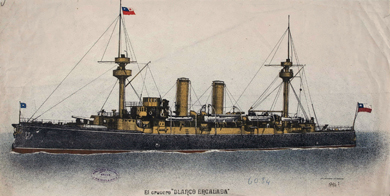
From a postcard src
Genesis of the Blanco Encalada
In 1892 the Argentine–Chilean naval arms race was in full swing. The Chilean Government worried about the recent orders in Britain by Argentina of the Elswick cruisers “9 de Julio” and “25 de Mayo”. The recent acquisition of the fleet, the protected cruisers Presidente Pinto and Errazuriz were indeed no match for them. As an answer a new acquisition plan asked for two large protected cruisers to be built also in Britain, despite their higher cost. It was for a new type that can outperform the two Argentinian ship withs a fair margin, both in armament and speed.
From this plan emerged two cruisers: Esmeralda and Blanco Encalada. They were by all accounts when launched, the world’s most powerful protected cruiser ever built. Chile’s first Esmeralda was ordered in Britain almost a decade earlier and was sold to the IJN on 15 November 1894 after some negociations (The Japanese at war with China just offered more)*. Funds were secured in London’s banks to built another cruiser later, which became the “second Esmeralda”, an even far larger ship, launched in 1894.
⚙ The naval Arms Race | |
 Armada de Argentina Armada de Argentina |  Armada de Chile Armada de Chile |
| Libertad class (BB) 1887 Veinticinco de Mayo (PC) 1890 Nueve de Julio (PC) 1891 Buenos Aires (PC) 1894 Garibaldi (AC) 1895 San Martín (AC) 1896 Pueyrredón (AC) 1897 General Belgrano (AC) 1898 Rivadavia, Moreno* (AC) 1901 |
Capitán Prat (BB*) 1887 Presidente Errázuriz (PC) 1887 Presidente Pinto (PC) 1887 Blanco Encalada (PC) 1892 Esmeralda (AC) 1894 Ministro Zenteno (PC) 1894 O'Higgins (AC) 1896 Constitución class (BB) 1901 Chacabuco (PC) 1901 |
But Blanco Encalada was the first of the two completed, because an opportunity presented itself to the Chilean naval attaché in London, when Philipp Watts, the new chief designer of the Armstrong Yards, proposed to repeat the Yoshino design for Japan for the Argentinians, featuring a more balanced mix of main and secondary guns. Design cost was reduced but still, she was a completely different animal and nowhere near a “sister ship” to Yoshino (see later).
*Selling ships to other governments was not new to Chile. In 1881, a 1380t unprotected cruiser was ordered to Britain, designed by Georges Rendel. She was naled Arturo Prat, but was resold after completion, even before she could make the trip across the Atlantic, to Japan. She became IJN Tsukushi. The second example was the Esmeralda, first of the name, a 2,950 tonnes Armstrong protected cruiser cruiser launched in June 1883, also designed by Georges Rendel. She was sold also to Japan on 15 November 1894, as IJN Idzumi, to take part in the 1st Sino-Japanese war.
The protected cruiser Blanco Encalada was purchased for £333,500. She was the second of the name, the previous ship being an armored frigate, flagship of the parlementarians during the civil war. She was sunk in 1891 by loyalists ships, notably a torpedo boat. The name was to honor Manuel José Blanco y Calvo de Encalada, vice-admiral in the Chilean Navy, independence hero, and political figure as Chile’s first President. Construction was ordered from Armstrong Mithell, Withworth & Co. Ltd Shipyards in Elswick (Newcastle upon Tyne) in 1892. Most sources cannot give a precise date.
She was launched on September, 9, 1893.
Design of the class
Hull and general design
So Blanco Encalada was basically a derivative of the “Yoshino”. The latter displaced 4,150 long tons (4,217 t) for 109.72 m (360 ft) long overall, 14.17 m (46 ft 6 in) in beam and 5.18 m (17 ft) in draft. The Chilean Cruiser was a bit larger at 4,568t fully loaded, for 112.78 meters between perpendiculars (370 feets), but the same beam at 14.17 meters and deeper draught at 5.6 meters (18 feet 6 in). Overall the hulls looked similar, typical Elswick cruiser design with steel housing, waterproof compartments underwater, low forecastle and twin funnels, two military masts with fighting tops and spotting tops mounted close to one another. The prow was reinforced for ramming and decorated with golen-pained motives recalling Chile’s first president records in latin, and Chile’s presidential armories and symbols.
The main difference however of this design compared to the Yoshino and Argentinian cruisers was the placement of the bridge, behind the formast.
Blanco Encalada’s crew consisted of 427 men. Her steel was divided underwater into 14 watertight compartments and also unlike the Yoshino, she had no forecastle but a continuous deck. The prow with spur was also designed a bit differently. Her stern poop was typical of the time, pointy, and also decorated. For better tenure in heavy weather, the hull was given two lateral counter-keels 40 meters long (131 feet). She had six utility boats under davits along the battery deck usable for landing parties, two more smaller aft, and a single 2nd class 60-ft torpedo boat on deck, served by the mainmast’s boom crane.
Armour protection layout
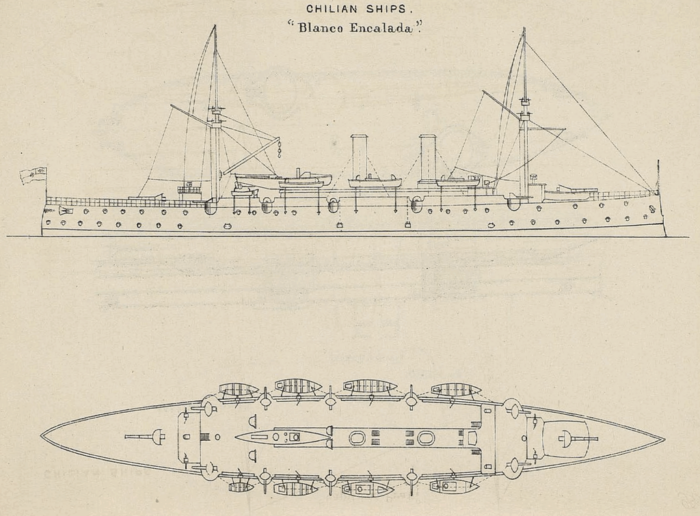
Brassey’s 1894 edition of the naval annual – 2 views of the ship.
Blanco Encalada had no belt but instead a typical “turtleback” style armored deck which was 4 inches (100 mm) thick on its side slopes, connecting to vertical surfaces. Closer to the central section, it went to 3-inches (76 mm), and then 1-3/4 inches (44 mm) for the vertical section at the center of the ship. But this was a complete protective deck, running for the whole ship’s lenght. This was distributed unlike Yoshino, which had a thickness ranging from 115 mm (4.5 in) on the slope to 45 mm (1.8 in) on flat. The rest of the armoured parts were the forward conning tower located behind the foremast under the bridge, which had 6-in (150 mm) walls, and the 8-inches/40 main guns were protected by 6-inches gun shields while the battery deck guns (6-in/40) had 51 mm (2 in) shields. Yoshino’s main guns were protected “only” by 115 mm (4.5 in) at the front.
Powerplant
Blanco Encalada was given two shafts propellers, driven by two Vertical Triple Expansion Steam Engine, fed by eight boilers for a total output of 14,600 hp, which was enough for 22.8 knits Maximum. Commpared to Yoshino, the latter was a bit more powerful, with 2-shaft VTE reciprocating engines and 12 boilers of 15,000 shp, and so faster as she was smaller at 23 knots.
As for range, Blanco Encalada was limited to 3350 nautical miles at 9 knots, based on a standard coal load of 350 tonnes, which can be ported in wartime to 866 or even 900 tonnes in some sources, whereas Yoshino carried 1,000 tonnes and could cover 9,000 nmi (17,000 km) at 10 kn (12 mph; 19 km/h). But her armament was nowhere near the Chilean cruiser.
Armament

Conway’s rendition.
There is no comparison between Yoshino and Blanco Encalada on this topic. They were of two different classes and the latter could have certainly sunk the former with ease in a regular duel. Indeed, where Yoshino sported four QF 6 inch/40 naval gun and eight QF 4.7 in Gun Mk I–IV plus 22 QF 3 pdr Hotchkiss, the Chilean warship was given two much larger main guns, 8-inches, ten of the same QF 6-in/40, and instead of a homogeneous light battery of 22 guns, 24 Hotchkiss rapid fire guns divided equally between 47mm (6-pdr), and 37mm (1-pdr) QF guns. Only common point was their five 457 mm (18-in) torpedo tubes, submerged fore and aft.
The two 8-in/40 were located on the fore and aft decks, the ten 6-in/40 were located on either beam on the central battery deck, sponsoned (the ones at the four corners fore and aft had a better arc of fire), and shielded. The twelve 3-pdr were likely placed close to the superstructures (2 either side) plus four in pairs on superstructure roofs fore and aft, four in casemated positions fore and aft of the hull. For the 1-pdrs its more complicated. There were two on each of the fighting tops facing fore and aft, the rest in the superstructures and deck. In the absence of a good yard model or detailed blueprint, no way to tell. Brassey’s scheme in 1894 even shows two 1-pdr in the fighting tops and in the spotting tops above (which became secondary fighting tops), while projectors were located in place of the paired 3-pdrs on the superstructures. Conway’s rendition is likely more consistent, showing the projectors relocated on the spotting tops. It is labelled “as completed” by the way.
As for her single 60-foote midget torpedo boat, she was likely of the type carried by the experimental HMS Vulcan torpedo mothership. It is unlikely she was kept for long either due to the poor performances of the type. These were meant to be used in clear weather, calm seas by night to infiltrate an harbour. The Brassey’s diagram is more explicit on the type, she was single funneled and had a single tube mounted forward, sloped downards to the bow, with the small shielded helm behind. She probably had a single boosted loco boiler, single screw propeller.
Blanco Encalada over time had her armament revised, if nothing else. She never had a full reconstruction and was completely obsolete by 1939. In 1920 when starying a new career as TS, she saw the removal of all her 3-pdr guns, all her 1-pdr guns and all her five torpedo tubes. She kept her main armament, and gained five modern 3-in (76mm)/40 Armstrong AA guns, a single 2-pdr (40mm)/39 QF Mk II “PomPom” AA gun as well. Needless to say the midget torpedo boat was removed a while ago.

Author’s illustration
⚙ specifications |
|
| Displacement | 4,568 t standard |
| Dimensions | 112.8 pp x 14.17 x 5.6 m (370ft 45ft 6in x 18ft 6in ft) |
| Propulsion | 2 shafts VTE, 8 Cyl. Boilers 14,600 ihp |
| Speed | 22.8 knots () |
| Range | Coal 350/866 tonnes, ? nmi at 10 knots |
| Armament | 2x 8-in/40, 10x 6-in/40, 12x 3-pdr, 12x 1-pdr, 5x 18-in TTs, 1x 60ft TB |
| Armor | Protective deck 1-3/4, 3-4 in, gunshields & CT 6-in |
| Crew | 427 |
Links/Sources
Links
on en.wikipedia.org/
on facebook.com/
on mardechile.cl/
on memoriachilena.cl/
on navypedia.org/
on armada.cl/
The former namesake armoured frigate, sunk during the civil war
Career
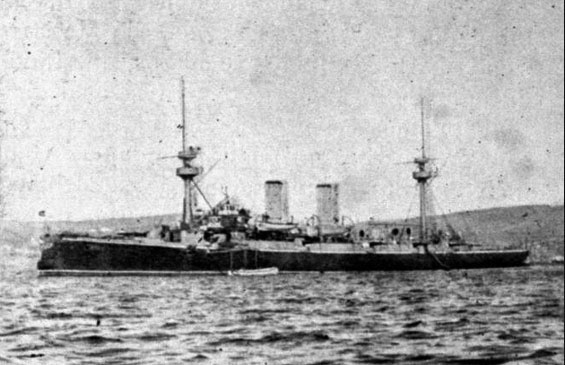
Blanco Encalada in 1903, Valparaiso
Blanco Encalada lacked protection but was fast, well armed, for a still modest size and had a long active career, serving during the two world wars, from 1920 she became a training ship, rearmed.
She compensated her pre-1920 actions by her assistance after an earthquake in 1939.
Early Career
After completion, Blanco Encalada departed for the south Atlantic, via the Azores. She arrived at Valparaíso under command of Captain Joaquín Muñoz Hurtado on January 26, 1895.
She served as a Training Ship part-time in the early years, and also as station ship in Magallanes with the Artillery School. In December 1906 she was involved in the repression of workers in the Saltpeter mines, railroads and harbour in Antofagasta. On 17 December 1907 she brought troops from Arica to Iquique, repressing thousands of miners from nitrate northern mines, as per government orders. The miners demonstrated to improve their living and working conditions. The government’s troops also committed the Santa María School massacre in Iquique but the crew did not took part in it. She was refitted in 1909 and 1920 and her post-1909 refit consisted in a boilers change. Her speed was maintained to 22 knots. Her service was mostly routine with nothing notably in her logbooks apart the usual training cruises down to the icy southern waters or to the Pacific.
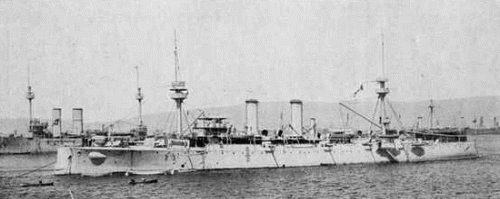
Blanco Encalada in 1918
Action in “1939 Earthquake”.
The people of Tomé and the surrounding area erected a bronze plaque as an expression of gratitude towards the Captain, Officers and ratings of the cruiser Blanco Encalada for their actions as a result of the earthquake of January 24 of 1939, which devastated the region, 82 yars later, in 2021.
At 11:32 p.m. of that tragic night, the Chilean cruiser was heading through the Bay of Concepción, preparing to drop anchor in Talcahuano, when water went boiling, shaking her superstructure. But it was not an earthquake which was to be reported in the notebooks at first. Earlyimpressions experienced by the personnel on duty at the Command Bridge that night was that the conclude that the ship had collided with somehing. Howevere blackout lights and fires in the distance revealed the earthquake.
Alert was instantly given, Captain Horacio Vío Valdivieso scrambling the crew and equipment, mounting two landing companies one one hundred sailors and ten officers to act in Tomé, the port designated for landing in the event of an emergency. In this place, all support were to be concentrated, helping in evacuating the most seriously injured to Valparaíso’s hospital. Foerunately she was not alone. The crews of British cruisers cruisers HMS Exeter, Ajax and Achilles, in the region well before their fight against KMS Graf Spee as part of the Falklands squadron, were already in a state of alert as the Second World War grew near.
These were hours of intense emotion for the naval detachment under command of Midshipman Víctor Varela Lamas, in the badly striken Coelemu, where the level of damage and human suffering were overwhelming, faithfully reflected in the bronze plaque of Tomé. This was reported as such by Don Manuel Chamorro Moreno in 2015:
The people of Tomé and the surrounding area, record in this bronze, the perennial expression of their feelings of gratitude, towards the Chief, Officers and Seafarers of the cruise ship “Blanco Encalada”, for their actions as a result of the earthquake of January 24 of 1939, which devastated the region. In this way, the feeling of a people grateful for the great collaboration provided by this distinguished crew, in the cataclysm that affected the region 76 years ago, bears witness to history.
The events were faithfully reflected in the bronze plaque that the people of Tomé gave to the commander of “Blanco Encalada”, Captain Horacio Vío Valdivieso, which is solemnly protected in the Chilean Navy’s log, as an example that distinguishes the generosity of its crews, throughout its history. “What a Bravo Zulu in the memory, for the distinguished crew of the cruise ship “Almirante Blanco Encalada”
Late Career 1940-45
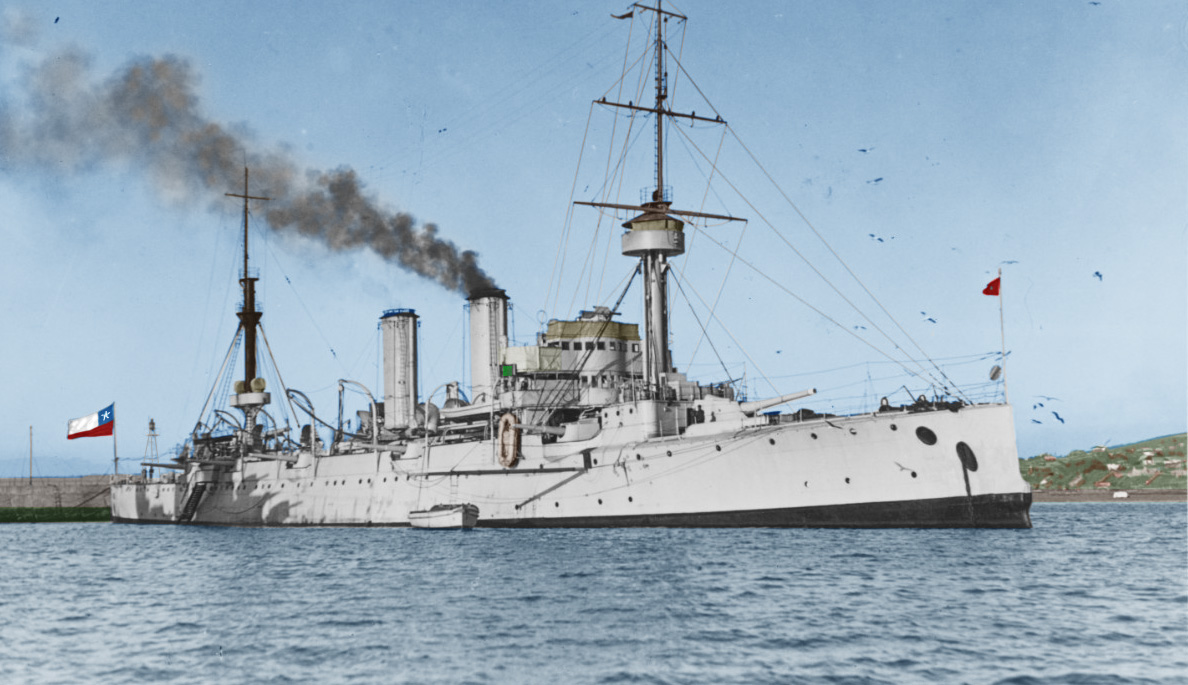
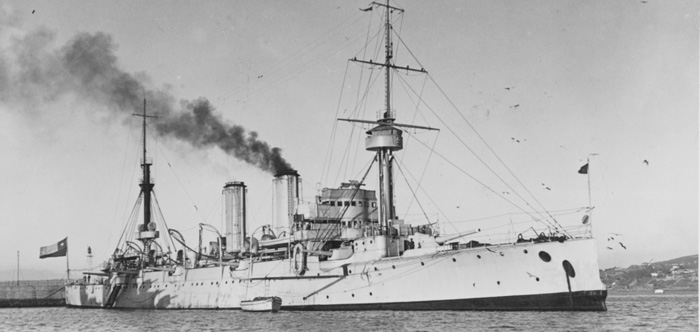
Blanco Encalada in November 1942, colored and the original src
Soon after these events, Blanco Encalada went into reserve, in 1940. She was discharged from service. She was still there in WW2, laid up, used as a hulk until stricken on 19 December 1945 by Supreme Decree No. 2,197 and sold for BU. Some proposed to have her preserved as a museuml ship, but this never was adopted. Overall, Blanco Encalada was a rather successful design. She even served as a prototype for the rival Argentinian cruiser Buenos Aires upon express Argentinian instructions (quite a compliment), but was also declined for China as Hai Chi, and simply enlarged to produced the next Esmeralda (ii).


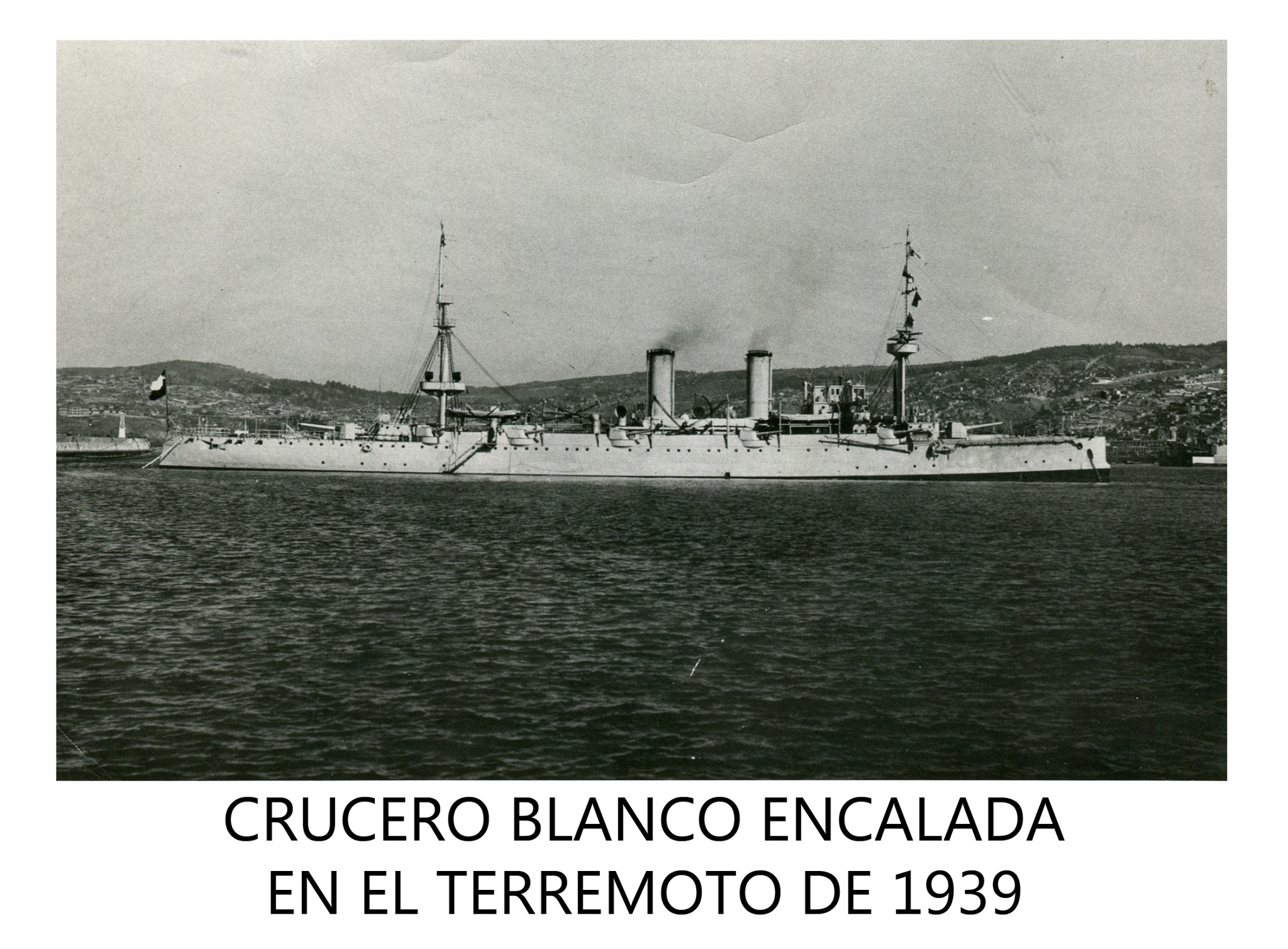
 Latest Facebook Entry -
Latest Facebook Entry -  X(Tweeter) Naval Encyclopedia's deck archive
X(Tweeter) Naval Encyclopedia's deck archive Instagram (@navalencyc)
Instagram (@navalencyc)





 French Navy
French Navy Royal Navy
Royal Navy Russian Navy
Russian Navy Armada Espanola
Armada Espanola Austrian Navy
Austrian Navy K.u.K. Kriegsmarine
K.u.K. Kriegsmarine Dansk Marine
Dansk Marine Nautiko Hellenon
Nautiko Hellenon Koninklije Marine 1870
Koninklije Marine 1870 Marinha do Brasil
Marinha do Brasil Osmanlı Donanması
Osmanlı Donanması Marina Do Peru
Marina Do Peru Marinha do Portugal
Marinha do Portugal Regia Marina 1870
Regia Marina 1870 Nihhon Kaigun 1870
Nihhon Kaigun 1870 Preußische Marine 1870
Preußische Marine 1870 Russkiy Flot 1870
Russkiy Flot 1870 Svenska marinen
Svenska marinen Søværnet
Søværnet Union Navy
Union Navy Confederate Navy
Confederate Navy Armada de Argentina
Armada de Argentina Imperial Chinese Navy
Imperial Chinese Navy Marinha do Portugal
Marinha do Portugal Mexico
Mexico Kaiserliche Marine
Kaiserliche Marine 1898 US Navy
1898 US Navy Sovietskiy Flot
Sovietskiy Flot Royal Canadian Navy
Royal Canadian Navy Royal Australian Navy
Royal Australian Navy RNZN Fleet
RNZN Fleet Chinese Navy 1937
Chinese Navy 1937 Kriegsmarine
Kriegsmarine Chilean Navy
Chilean Navy Danish Navy
Danish Navy Finnish Navy
Finnish Navy Hellenic Navy
Hellenic Navy Polish Navy
Polish Navy Romanian Navy
Romanian Navy Turkish Navy
Turkish Navy Royal Yugoslav Navy
Royal Yugoslav Navy Royal Thai Navy
Royal Thai Navy Minor Navies
Minor Navies Albania
Albania Austria
Austria Belgium
Belgium Columbia
Columbia Costa Rica
Costa Rica Cuba
Cuba Czechoslovakia
Czechoslovakia Dominican Republic
Dominican Republic Haiti
Haiti Hungary
Hungary Honduras
Honduras Estonia
Estonia Iceland
Iceland Eire
Eire Equador
Equador Iran
Iran Iraq
Iraq Latvia
Latvia Liberia
Liberia Lithuania
Lithuania Mandchukuo
Mandchukuo Morocco
Morocco Nicaragua
Nicaragua Persia
Persia San Salvador
San Salvador Sarawak
Sarawak Uruguay
Uruguay Venezuela
Venezuela Zanzibar
Zanzibar Warsaw Pact Navies
Warsaw Pact Navies Bulgaria
Bulgaria Hungary
Hungary

 Bundesmarine
Bundesmarine Dutch Navy
Dutch Navy Hellenic Navy
Hellenic Navy Marina Militare
Marina Militare Yugoslav Navy
Yugoslav Navy Chinese Navy
Chinese Navy Indian Navy
Indian Navy Indonesian Navy
Indonesian Navy JMSDF
JMSDF North Korean Navy
North Korean Navy Pakistani Navy
Pakistani Navy Philippines Navy
Philippines Navy ROKN
ROKN Rep. of Singapore Navy
Rep. of Singapore Navy Taiwanese Navy
Taiwanese Navy IDF Navy
IDF Navy Saudi Navy
Saudi Navy Royal New Zealand Navy
Royal New Zealand Navy Egyptian Navy
Egyptian Navy South African Navy
South African Navy






























 Ukrainian Navy
Ukrainian Navy dbodesign
dbodesign